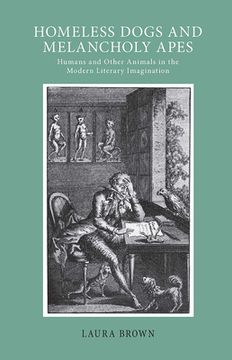Share
Homeless Dogs and Melancholy Apes: Humans and Other Animals in the Modern Literary Imagination (in English)
Laura S. Brown
(Author)
·
Cornell University Press
· Paperback
Homeless Dogs and Melancholy Apes: Humans and Other Animals in the Modern Literary Imagination (in English) - Brown, Laura S.
$ 33.09
$ 41.36
You save: $ 8.27
Choose the list to add your product or create one New List
✓ Product added successfully to the Wishlist.
Go to My WishlistsIt will be shipped from our warehouse between
Friday, June 21 and
Monday, June 24.
You will receive it anywhere in United States between 1 and 3 business days after shipment.
Synopsis "Homeless Dogs and Melancholy Apes: Humans and Other Animals in the Modern Literary Imagination (in English)"
In eighteenth-century England, the encounter between humans and other animals took a singular turn with the discovery of the great apes and the rise of bourgeois pet keeping. These historical changes created a new cultural and intellectual context for the understanding and representation of animal-kind, and the nonhuman animal has thus played a significant role in imaginative literature from that period to the present day.In Homeless Dogs and Melancholy Apes, Laura Brown shows how the literary works of the eighteenth century use animal-kind to bring abstract philosophical, ontological, and metaphysical questions into the realm of everyday experience, affording a uniquely flexible perspective on difference, hierarchy, intimacy, diversity, and transcendence. Writers of this first age of the rise of the animal in the modern literary imagination used their nonhuman characters--from the lapdogs of Alexander Pope and his contemporaries to the ill-mannered monkey of Frances Burney's Evelina or the ape-like Yahoos of Jonathan Swift--to explore questions of human identity and self-definition, human love and the experience of intimacy, and human diversity and the boundaries of convention. Later literary works continued to use imaginary animals to question human conventions of form and thought.Brown pursues this engagement with animal-kind into the nineteenth century--through works by Mary Shelley, Charles Dickens, and Elizabeth Barrett Browning--and into the twentieth, with a concluding account of Paul Auster's dog-novel, Timbuktu. Auster's work suggests that--today as in the eighteenth century--imagining other animals opens up a potential for dissonance that creates distinctive opportunities for human creativity.
- 0% (0)
- 0% (0)
- 0% (0)
- 0% (0)
- 0% (0)
All books in our catalog are Original.
The book is written in English.
The binding of this edition is Paperback.
✓ Producto agregado correctamente al carro, Ir a Pagar.

